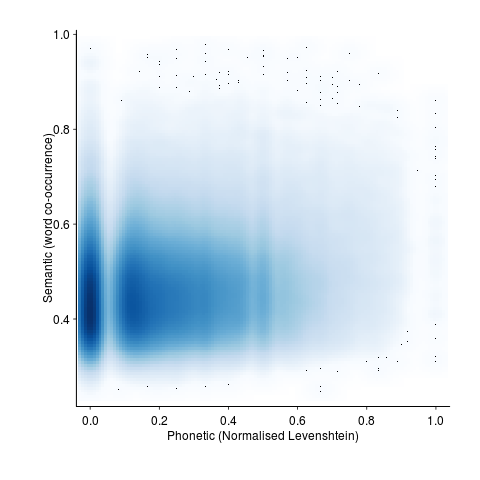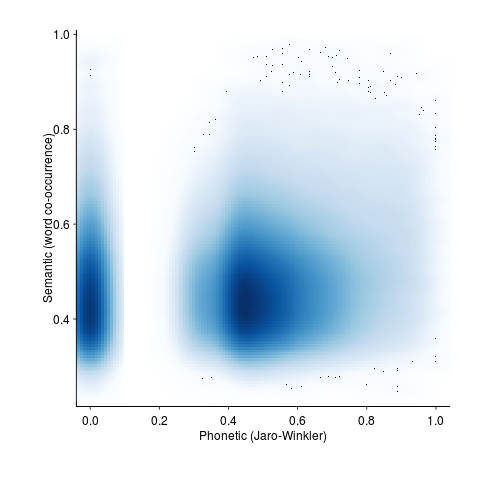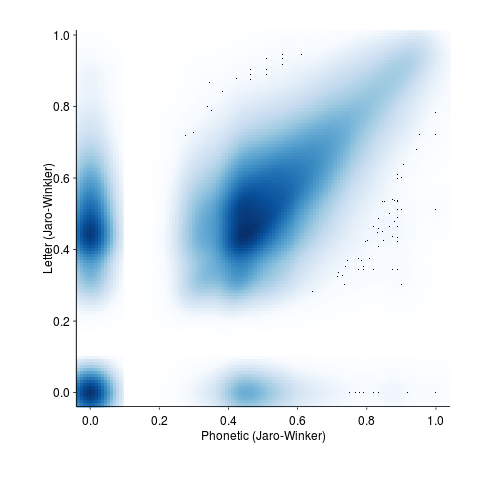Semantic vs phonetic similarity for word pairs: a weekend investigation
The Computational Semantics hackathon was one of the events I attended last weekend. Most if the suggested problems either looked like they could not reasonably be done in a weekend (it ran 10:00-17:00 on both days, I know academics hacks) or were uninspiring coding problems. Chatting to some of the academics present threw up an interesting idea that involved comparing word pair semantic and phonetic similarity (I have written about my interest in sounds-like and source code identifiers).
Team Semantic-sounds consisted of Pavel and yours truly (code and data).
The linguists I chatted to seemed to think that there would be a lot of word pairs that sounded alike and were semantically similar; I did not succeed it getting any of them to put a percentage to “a lot”. From the human communication point of view, words that both sound alike and have a similar meaning are likely to be confused with each other; should such pairs come into existence they are likely to quickly disappear, at least if the words are in common usage. Sound symbolism related issues got mentioned several times, but we did not have any data to check out the academic enthusiasm.
One of the datasets supplied by the organizers was word semantic similarity data extracted from the Google news corpus. The similarity measure is based on similarity of occurrence, e.g., the two sentences “I like licking ice-cream” and “I like eating ice-cream” suggest a degree of semantic similarity between the words licking and eating; given enough sentences containing licking and eating there are clever ways of calculating a value that can be viewed as a measure of word similarity.
The data contained 72,000+ words, giving a possible half a billion pairs (most having zero similarity). To prune this down a bit we took, for each word, the 150 other words that were most similar to it, giving around 10 million word pairs. Each word was converted to a phoneme sequence and a similarity distance calculated for each pair of phoneme sequences (which we called phonetic distance and claimed it was a measure of how similar the words sounded to each other).
The list of word pairs with high semantic/phonetic similarity was very noisy, with lots of pairs containing the same base word in plural, past tense or some other form, e.g., billion and billions. A Porter stemmer was used to remove all pairs where the words shared the same stem, reducing the list to 2.5 million pairs. Most of the noise now came from differences in British/American spelling. We removed all word pairs that contained a word that was not in the list of words that occurred in the common subset of the British and American dictionaries used by aspell; this reduced the list to half a million pairs.
The output contained some interesting pairs, including: faultless/flawless, astonishingly/astoundingly, abysmal/dismal and elusive/illusive. These look like rarely used words to me (not enough time to add in word frequency counts).
Some pairs had surprisingly low similarity, e.g., artifact/artefact (the British/American spelling equality idea has a far from perfect implementation). Is this lower than expected semantic similarity because there is a noticeable British/American usage difference? An idea for a future hack.
A smoothed scatter plot of semantic vs phonetic similarity (for the most filtered pair list) shows lots of semantically similar pairs that don’t sound alike, but a few that do (I suspect that most of these are noise that better stemming and spell checking will filter out). The following uses Levenshtein distance for phoneme similarity, normalised by the maximum distance for a given phoneme sequence with all phoneme differences having equal weight:

and using Jaro-Winkler distance (an alternative distance metric that is faster to calculate):

The empty band at low phonetic similarity is an artifact of the data being quantized (i.e., words contain a small number of components).
Is it worth going to the trouble of comparing phoneme sequences? Would comparing letter sequences be just as good? The following plot shows word pair letter distance vs phonetic similarity distance (there is a noticeable amount of off-diagonal data, i.e., for some pairs letter/phoneme differences are large):

Its always good to have some numbers to go with graphical data. The following is the number of pairs having a given phonetic similarity (remember the starting point was the top 150 most semantically similar pairs). The spikes are cause by the discrete nature of word components.

Squinting at the above it is possible to see an exponential decline as phonetic word similarity increases. It would be interesting to have enough data to display a meaningful 3D plot, perhaps a plane can be fitted (with a log scale on the z-axis).
Rather than using the Google news corpus data as the basis of word pair semantic similarity we could have used the synonym sets from Wordnet. This rather obvious idea did not occur to me until later Saturday and there was no time to investigate. How did the small number of people who created the Wordnet data come up with lists of synonyms? If they simply thought very hard they might have been subject to the availability bias, preferentially producing lists of synonyms that contained many words that sounded alike because those that did not sound alike were less likely to be recalled. Another interesting idea to check out at another hack.
It was an interesting hack and as often happens more new questions were raised than were answered.
Recent Comments